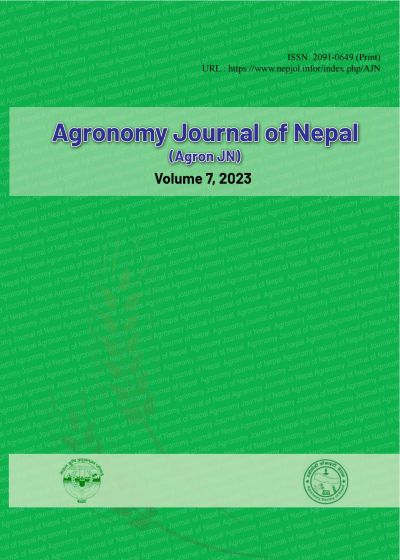Effects of Nitrogen Levels on Growth and Yield of Some Newly Released Wheat Genotypes under Bhairahawa Condition
DOI:
https://doi.org/10.3126/ajn.v7i1.62086Keywords:
Economics, Nitrogen level, Wheat genotypes, YieldAbstract
The newly released wheat varieties with different nutritional demands and their yield potential hinder generalized recommendations for nitrogen (N) fertilization. Field experiments were carried out during 2018/19 and 2019/20 growing seasons to evaluate the response of varying N fertilizer rates on growth and yield parameters of two newly released wheat varieties (Borlaug 2020 and Zinc Gahun-1), one promising line (NL 1179) and Vijay as a check variety. Five N levels (i.e. 0, 50,100,150 and 200 kg N ha-1) were applied in the experiment designed in split plot with three replications. Nitrogen levels and genotypes were allocated as main plot and sub plot treatments, respectively. The combined analysis of both growing seasons indicated that, all newly released and promising genotypes performed better than check variety. NL 1179 recorded the highest grain yield followed by Borlaug 2020 and Zinc Gahun-1. A linear increase of grain yield was observed with increased rate of N from 0 to 200 kg ha-1, while 200 kg N ha-1showed significantly (p<0.001) highest grain yield which was statistically at par with 150 kg N/ha. Similarly, gross margin (Rs. 148933 ha-1) was highest with the application of N @ 150 kg ha-1. Interaction effect of genotypes and N levels was not found significant. Thus, it can be concluded that for higher grain production of improved wheat varieties, 150 kg Nha-1could be recommended under Bhairahawa condition.
Downloads
Downloads
Published
How to Cite
Issue
Section
License
Copyright (c) 2023 Agronomy Society of Nepal (ASoN)

This work is licensed under a Creative Commons Attribution-NonCommercial 4.0 International License.
ASON permits for free use, distribution and reproduction in any medium if the original work is properly cited and not used for commercial purposes.




